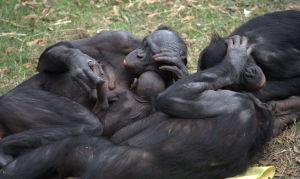Part I: An Introduction to Paleoanthropology
4. Primate Social Organization
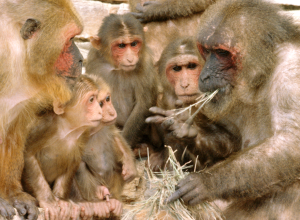
Most primates live in groups. The best explanation for why animals form groups and endure the costs of feeding competition is to minimize the risk of predation. Grouping patterns are tied to diet and the defensibility of resources. Females are out to maximize resources for themselves and their offspring, so as to maximize their reproductive success. If a species eats grass or leaves, it does not make sense to defend those resources. However, there is safety in numbers and those species (especially arboreal species) will normally be found living or foraging in small groups. If a species specializes on ripe fruit, they cannot defend them because of the patchy nature of fruit in geographic space and time. In the case of the few primate ripe fruit specialists, such as chimps and spider monkeys, males defend a home range that contains resources that females need, and thus females are attracted to join them. While orangutans are also preferentially frugivorous, they are solitary due to their large size and strict arboreality, which limits resources to those that are accessible from supporting branches. Finally, if a species can eat a variety of things that come in variable-sized patches, they can band together and defend those resources as they come across them in their daily ranging. In that case, females stay together in their natal group (termed female philopatry) and cooperate in resource defense.
Social organization involves several aspects of group life, such as (1) the average numbers of individuals in terms of age and sex; (2) whether group members remain in their natal group at maturity or leave, and hence whether individuals have relatives in the group; (3) whether those animals that join a group in adulthood stay permanently or tend to leave after a period of time; (4) the pattern of interactions between individuals, e.g. whether there is a dominance hierarchy and if so, if an individual’s position in the hierarchy is permanent or temporary; and (5) the number of potential mates to which an individual has access. While we tend to categorize species by their grouping pattern or social organization, it is increasingly apparent that there is variability within primate species. Some species share our pattern of living in multi-male/multi-female groups. Other categories of primate social organization are solitary, male-female pairs, and one-male/multi-female groups. Interestingly, all of the mating systems seen in primates, i.e. monogamy, polygyny (one male mates with multiple females), polyandry (one female mates with multiple males), and polygynandry (both males and females are promiscuous), are also seen in humans. Some men and women marry or mate for life; some men have multiple wives or partners, and the same goes for some women. I will discuss each type of social organization and mating pattern seen in the primates, along with example species.
SOLITARY AND DISPERSED POLYGYNY
Except for the orangutans, solitary foragers are small nocturnal prosimians that forage primarily for insects and fruit. Examples of solitary foragers are the bushbabies (see Figure 4.2) and pottos of Africa, most of the nocturnal lemurs of Madagascar, and the lorises of Asia. I am going out on a limb (too much?) to suggest that our earliest primate ancestors were as well, since we are thought to be descended from a small, insectivorous, nocturnal mammal. Prosimian solitary foragers either avoid predation by stealth (i.e. the slow climbers, such as pottos and slow lorises) or a form of locomotion termed vertical clinging and leaping (e.g., bushbabies) that allows for quick getaways. Females usually forage alone and either park their young nearby or leave them in a “nest,” such as a tree hole. Sleeping groups may consist of female relatives and their young and/or females, young, and males, depending on the species and female-female tolerance. Male home ranges often overlap multiple female home ranges, and males monitor female sexual cycles by “making the rounds” and monitoring their scent, hence the use of the term “dispersed polygyny,” i.e. one male and multiple dispersed females. One male may dominate other smaller or less dominant males in an area and may suppress them from breeding, via pheromonal activity.
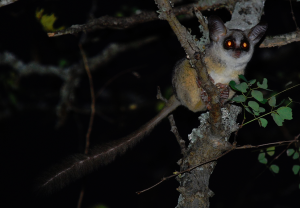
As mentioned, orangutans are the odd man out. They are large and arboreal so they do not need to group for protection. They need a lot of resources to support them and at some sites, they suffer periodic food shortages, so that grouping would hinder foraging. Females and their dependent offspring forage together. Females maintain proximity and mate with a dominant male with developed secondary sexual characteristics, i.e. large size, a throat sac for loud calls, and facial flanges. Until there is an opportunity for males to acquire females, such as when a large male dies, males stay small and mate opportunistically. Scientists are stymied at how they can delay maturation and then facultatively develop into the larger morph.
TERRITORIAL PAIRS AND MONOGAMY
While a few species of primates are commonly referred to as monogamous, extrapair copulations have been observed in every one of them. The last primate to have lost the title of true monogamist was the night monkey of Central and South America. Prior to that revelation, it was always fun to ask my students who the only true monogamous primate species is and see if they answered, “humans.”
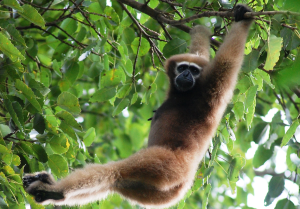
Monogamy begs the question, “why?” While females may benefit from a monogamous relationship, if their mate supports them or their offspring in some way, it is difficult to understand why males would tie themselves to one mate when mating is not costly for them. There are several theories regarding the adaptive significance of pairing in primates. First is the idea that the female needs help defending a territory in order to obtain enough resources for herself and her offspring. Couples may actively and/or passively defend their territories (hence the more appropriate term “territorial pair”) via threats, fighting, and/or duetting, i.e. calling together to indicate that the territory is occupied by a bonded pair. In the majority of species, males help by carrying offspring. The second theory suggests that monogamy is a way for males to protect their offspring from infanticide. In those species that form one-male groups (see next section), when a new male takes over, he may kill nursing infants. Once nursing is interrupted, a female undergoes hormonal changes and may return to estrus (fertile period). It is in the new male’s best interest to impregnate females as soon as possible, in the “hope” that some of his offspring will make it to the juvenile stage before the next male comes in and wipes out the infants. Why would females mate with a homicidal maniac, you ask? It is not in their best interest to wait to reproduce either. That is the way natural selection works! Those traits that maximize fitness, i.e. reproductive success, are favored. In addition, a male offspring that grows up to be infanticidal will be in a better position to reproduce, if he has what it takes to take over a group.
There are territorial paired species within the prosimians (indris and wooly lemurs of Madagascar and the tarsiers of the Southeast Asian archipelago), New World monkeys (night, titi, saki, and some marmoset monkeys of Central and/or South America), and the lesser apes (gibbons and siamangs of Southeast Asia—see Figure 4.3). We are learning that the lesser apes are much less monogamous than was previously thought. Females of some gibbon species tend toward polyandry and thus males are polygynous, making those species polygynandrous. We are the only great ape to have a tendency for monogamy, in that we tend to “fall in love” with one person at a time.
ONE-MALE GROUPS AND POLYGYNY
In some species, one male with one or a few females is the grouping pattern. However in other species (Hamadryas baboons, geladas, mandrills, drills, and some odd-nosed monkeys, such as snub-nosed monkeys), one-male units (OMUs) congregate into larger and larger groupings, in a multi-tiered or nested fashion, depending on their current activity. I will discuss this more complex grouping pattern after the discussion of one-male groups (OMGs). Except for the gorillas, all OMG species are Old World monkeys. The majority of the colobines form OMGs, e.g. African colobus monkeys of the genus: Colobus and Asian langurs and leaf monkeys. Cercopithecines of the genus: Cercopithecus (commonly known as guenons—see figure 4.4) and patas monkeys (Erythrocebus) are also OMG species.
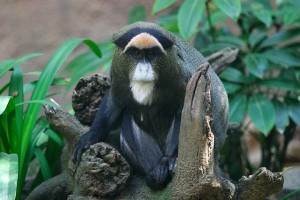
In the majority of OMG species, females are related but as groups get larger, they split along matrilines, meaning that a group of closely related females may splinter when competition increases. In addition, females may move between groups, especially in the colobines. Males fiercely compete for access to groups and infanticide occurs during takeovers. In those species that are seasonal breeders, it is difficult for the male to monitor and mate with all of the females and outsider males may sire some of the offspring. One guy can only do so much and females only have a small window of opportunity.
While the OMG makes sense for the colobines and their high leaf diet, it is not as clear why the more generalist guenons exhibit the same pattern. Like the colobine monkeys of Africa and Asia, it is possible that the ancestor of the extant arboreal guenons never left the trees and thus did not evolve the tendency for a larger grouping pattern in response to terrestrial predators. In addition, if they remained arboreal in relict forests, they may have enjoyed a more stable resource base. They are small- to medium-sized monkeys and thus can subsist on a variety of foods, primarily insects and fruit, both of which are indefensible food items, from a female perspective. Thus while a group is beneficial, it does not need to be large. It may be a bit of an oversimplification that female resources drive primate social organization, but it is a useful model with demonstrated heuristic value.
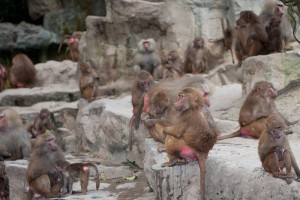
For those species with a nested grouping pattern of OMUs, I will describe the system in Hamadryas baboons (see Figure 4.5) and contrast it with geladas (see Figure 4.7). Both species consist of OMUs that congregate into three larger group levels. For some strange reason (as if there are not enough terms in a primate course), some primatologists use different terms for the levels in each of the species. The basic unit is the OMU. The next level is termed the clan; it consists of several OMUs, along with bachelor males, and the members tend to forage together (see Figure 4.6). The third level is the band, and that is the result of several clans congregating to forage over a large area. While Hamadryas bands are somewhat stable, gelada bands are not. Finally the troop (Hamadryas) or herd (gelada) is a combination of multiple bands that come together to sleep on cliffs in the mainly treeless regions where both species live, primarily in Ethiopia. Troops consist of hundreds of animals, over 700 in the Hamadryas and slightly fewer in the geladas. This odd grouping pattern is related to their harsh environment. Hamadryas live in subdesert conditions in Ethiopia and the Arabian Peninsula. They are generalists that eat whatever they can find. They fission and fuse (i.e. come together and separate again) into the various grouping levels as resources allow, but predators abound and shelter is scarce, so there is safety in numbers via vigilance. The geladas’ situation is a bit different. They live in high-altitude conditions in Ethiopia and eat a lot of grass and grass products, such as seeds and corms. Again, there is safety in numbers but resources are ubiquitous so they spread out a bit and mooch and munch (new foraging category!), i.e. sit-eat-move, along the ground. The strangest aspect of the two species (other than their bizarre faces!) is that Hamadryas are male philopatric and geladas are female philopatric. While the gelada pattern makes sense, considering their relatedness to female-philopatric baboon species, Hamadryas are even more closely related to those baboons yet appear to deviate from the pattern. However, the females do not go far; they transfer at the clan or band level and thus are not far from kin. Thus the real question is why do male Hamadryas stay?
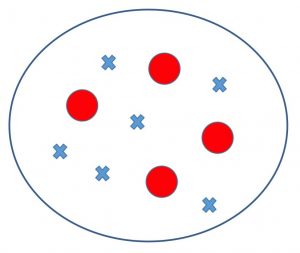
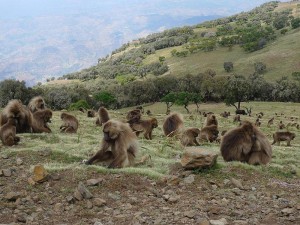
While there are regular takeovers in gelada OMUs, as would be expected, they are not as frequent in Hamadryas, primarily due to the facts that males have control over their small group of females and OMUs are surrounded by male relatives. Hamadryas females are usually coerced away from their mothers when they are young and then herded and punished by their new male leader until they learn to obey and not stray. Female geladas have a say in male takeovers; they either side with the resident male and help keep the new male out or they do not and the resident male is on his own. It is interesting that if a new male becomes established in the group, the former male may stay and help defend his offspring from becoming the victims of infanticide, but he can no longer breed.
ONE-FEMALE GROUPS AND POLYANDRY
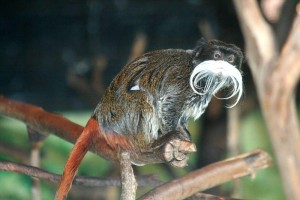
This type of social organization is seen only in the callitrichids, i.e. the tamarins (see Figure 4.8) and marmosets of Central and South America. Within those groups, there is usually only one breeding female and one or two breeding males. Females gestate as many as five fetuses but on average, only two survive. Hence we talk about “twinning” in the callitrichids. Those groups with an extra male have better offspring survival. At birth, the offspring average one-fourth of the female’s weight and thus foraging to support them is a full-time job for the females. The females nurse the young and the males carry and nurture them.
Females pheromonally suppress cycling in their daughters and while sons become fertile, they have no mating options in the group. Mature daughters and sons also help with the care of their younger siblings. Helping behavior, while delaying their direct fitness (genes they pass on via reproduction), increases their inclusive fitness (genes they share with relatives). Full siblings share half of their genes (the same as between parents and offspring) and half siblings share one-fourth, on average. While the proximate causation (current stimulus or condition favoring the behavior, versus ultimate causation, i.e. the behavior was favored by natural selection due to its fitness benefits) for older siblings to stay is unclear, it is likely adaptive in some situations to delay reproduction. For example, it may be difficult for young animals to compete for territory or mates, and they are small and inexperienced and thus easy prey.
MULTI-MALE/FEMALE GROUPS AND POLYGYNANDRY
There are two types of multi-male/female groups (MMF). The first is the more common. They are medium to large groups of related females (female philopatric) with a sex ratio skewed in favor of females. Outsider males may congregate in all-male bands. Females and males are promiscuous, the mating pattern known as polygynandry. Many New World monkey species and most of the Old World cercopithecines (e.g. macaques—see Figures 4.1 and 4.9) exhibit this type of social organization. Females cooperate in resource defense and males may have a more peripheral position within the group, except during the mating season in seasonal breeders. Many semi-terrestrial species exhibit this type of social organization, e.g. baboons (Hamadryas are the exception) and macaques. Terrestriality is associated with larger body and group size, likely for predation avoidance. With more females, come more males and with more males, females can benefit from seasonal breeding. There are enough males to go around and the glut of offspring that are then born reduces the probability that any one of them is eaten; i.e. the dilution effect. In addition, related females help keep watch over the young that then have playmates. Seasonal breeding is tied to environmental conditions, so that females benefit by timing events to coordinate with resource availability.

The second type of MMF is commonly called a community social organization. Species that exhibit this type of social organization are male philopatric ripe fruit specialists. As mentioned, females cannot defend fruit, so they do not band together into matrilines. Related males defend a territory that contains enough resources to attract females. Females and their offspring forage independently but group members come together periodically into larger aggregations, hence the other term for this type of social organization, fission-fusion. New World spider and muriqui monkeys and the chimps and bonobos of Africa (see figure 4.10) are all categorized as community species.
